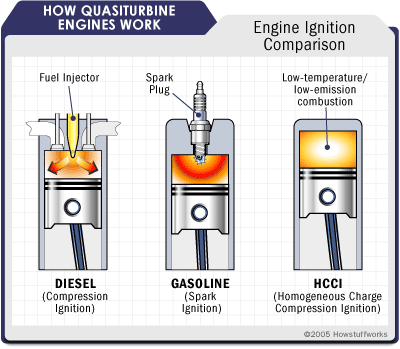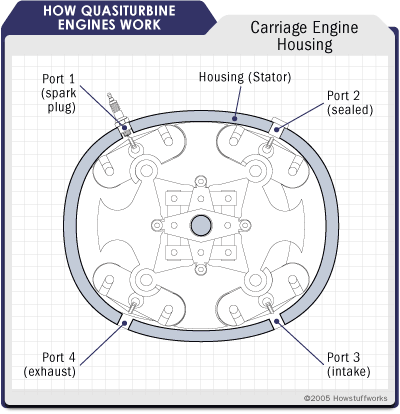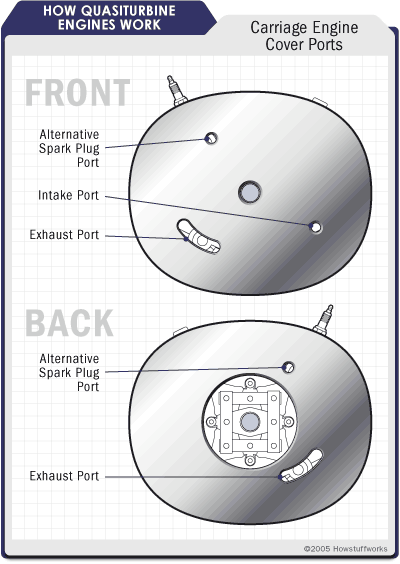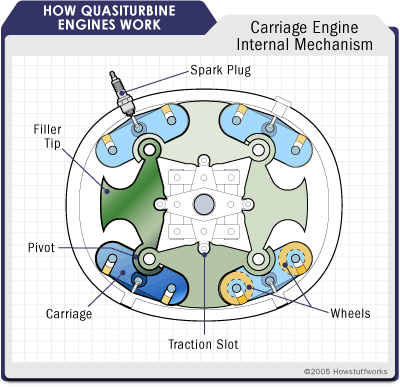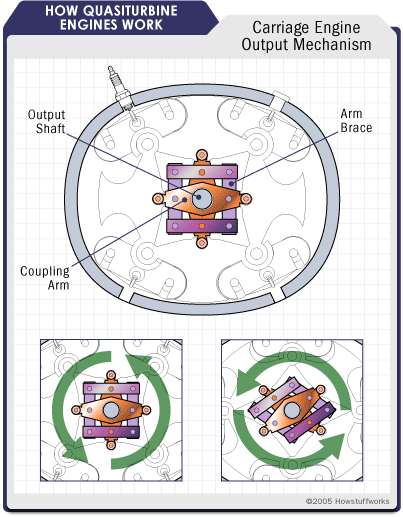
- •Quasiturbine engines
- •Ignite the fuel to create an explosion
- •In Type III, air and fuel are only partially mixed in the combustion chamber. This heterogeneous mixture is then compressed, which causes the temperature to rise until self-ignition takes place.
- •Quasiturbine with Carriages
- •Quasiturbines: Advantages and Disadvantages
In Type III, air and fuel are only partially mixed in the combustion chamber. This heterogeneous mixture is then compressed, which causes the temperature to rise until self-ignition takes place.
Finally, in Type IV, the best attributes of gasoline and diesel engines are combined. A premixed fuel-air charge undergoes tremendous compression until the fuel self-ignites. This is what happens in a photo-detonation engine, and because it employs a homogenous charge and compression ignition, it is often described as an HCCI engine. HCCI (Homogeneous Charge Compression Ignition) combustion results in virtually no emissions and superior fuel efficiency. This is because photo-detonation engines completely combust the fuel, leaving behind no hydrocarbons to be treated by a catalytic converter or simply expelled into the air.
|
Of course, the high pressure required for photo-detonation puts a significant amount of stress on the engine itself. Piston engines can't withstand the violent force of the detonation. And traditional rotary engines such as the Wankel, which have longer combustion chambers that limit the amount of compression they can achieve, are incapable of producing the high-pressure environment necessary for photo-detonation to occur.
Enter the Quasiturbine with carriages. Only this design is strong enough and compact enough to withstand the force of photo-detonation and allow for the higher compression ratio necessary for pressure-heated self-ignition.
Quasiturbine with Carriages
Even with its added complexity, the Quasiturbine engine with carriages has a relatively simple design. Each part is described below.
The housing (stator), which is a near oval known as the "Saint-Hilaire skating rink," forms the cavity in which the rotor rotates. The housing contains four ports:
A port where the spark plug normally sits (the spark plug can also be placed in the housing cover – see below).
A port that is closed with a removable plug.
A port for the intake of air.
An exhaust port used to release the waste gases of combustion.
|
The housing is enclosed on each side by two covers. The covers have three ports of their own, allowing for maximum flexibility in how the engine is configured. For example, one port can serve as an intake from a conventional carburetor or be fitted with a gas or diesel injector, while another can serve as an alternate location for a spark plug. One of the three ports is a large outlet for exhaust gasses.
|
How the various ports are used depends on whether the automotive engineer wants a traditional internal combustion engine or one that delivers the super-high compression required of photo-detonation.
The rotor, made of four blades, replaces the pistons of a typical internal combustion engine. Each blade has a filler tip and traction slots to receive the coupling arms. A pivot forms the end of each blade. The job of the pivot is to join one blade to the next and to form a connection between the blade and the rocking carriages. There are four rocking carriages total, one for each blade. Each carriage is free to rotate around the same pivot so that it remains in contact with the inner wall of the housing at all times.
|
Each carriage works closely with two wheels, which means there are eight wheels altogether. The wheels enable the rotor to roll smoothly on the contoured surface of the housing wall and are made wide to reduce pressure at the point of contact.
The Quasiturbine engine doesn't need a central shaft to operate; but of course, a car requires an output shaft to transfer power from the engine to the wheels. The output shaft is connected to the rotor by two coupling arms, which fit into traction slots, and four arm braces.
|
Notice that the Quasiturbine engine has none of the intricate parts of a typical piston engine. It has no crankshaft, valves, pistons, push rods, rockers or cams. And because the rotor blades "ride" on the carriages and wheels, there is little friction, which means oil and an oil pan are unnecessary.

